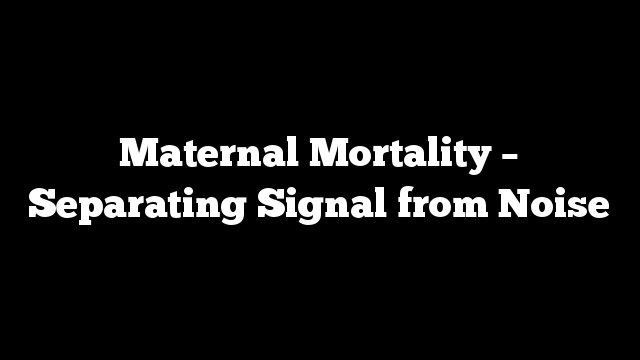
By AMEYA KULKARNI, MD
When Samuel Morse left his New Haven home to paint a portrait of the
Maquis du Lafayette in Washington DC, it was the last time he would see his
pregnant wife. Shortly after his arrival in Washington, his wife developed
complications during childbirth. A messenger took several days on horseback to
relay the message to Mr Morse. Because the trip back to New Haven took several
more, his wife had died by the time he arrived at their home. So moved was he by the tragedy of lost time
that he dedicated the majority of the rest of his life to make sure that this
would never happen to anyone again. His subsequent work on the telegraph and in
particular the mechanism of communication for the telegraph resulted in Morse
code – the first instantaneous messaging system in the world.
Mr Morse’s pain is not foreign to us in the 21st century. We feel the loss of new mothers so deeply that, when earlier this year new statistics on the rate of maternal death were released and suggested that American women died at three times the rate of other developed countries during child birth, doctors, patient advocates, and even Congress seemed willing to move heaven and earth to fix the problem. As someone who cares for expectant mothers at high risk for cardiovascular complications, I too was moved. But beyond the certainty of the headlines lay the nuance of the data, which seemed to tell a murkier story.
First at issue was the presentation of the data. Certainly, as a rate
per live births, it would seem that the United States lagged behind other OECD
countries – our maternal mortality rate was between 17.2 and 26.4 deaths per
100,000 live births, compared to 6.6 in the UK or 3.7 in Spain. But this
translated to approximately 700 maternal deaths per year across the United
States (among approximately 2.7 million annual births). While we would all agree
that one avoidable maternal death is one too many, the low incidence means that
small rates of error could have weighty implications on the reported results.
For instance, an error rate of 0.01% would put the United States in line with
other developed countries.
Surely, the error rate could not account for half the reported
deaths, right? Unfortunately, it is difficult to estimate how close to reality
the CDC reported data is, primarily because the main source data for maternal
mortality is a single question asked on the application for death certificates.
The question asks whether the deceased was pregnant at the time of death,
within 42 days of death, or in the 43 to 365 days prior to death. While
pregnancy at the time of death may be easy to assess, the latter two categories
are subject to significantly more error.
Just how much error is remarkably uncertain. One program called Review to Action attempted to ascertain this error rate by using Maternal Mortality Review committees to better understand the real causes of death among women who died around the time of the birth of their child. They looked at data from four states (Colorado (2008-12), Delaware (2009-14), Geogia (2012-13), and Ohio (2008-12)) to see if a deeper look at maternal deaths could uncover the true drivers of maternal mortality. Of the 650 deaths examined, 97 had no evidence of pregnancy in the year prior to death, a false positive rate of 15%. Among the remaining 553 deaths deemed “pregnancy associated” (death within one year of being pregnant), only 175 were thought to be pregnancy related, defined as “the death of a woman during pregnancy or within one year of the end of pregnancy from a pregnancy related complication, a chain of events initiated by pregnancy, or the aggravation of an unrelated condition by the physiologic effects of pregnancy.” If this number was used to define maternal mortality, the rate would be 5.8/100,000 births, similar to other OECD countries.
Of course, this is an unfair comparison, because there is great
variation in how maternal mortality rates are calculated across the world. Moreover,
the rate of error in small numbers has as much likelihood of underreporting as
it does overreporting. But it does demonstrate a core problem in the
measurement of maternal mortality. Because the numbers are so small to begin
with, small errors have the risk of having significant effects on the results.
Even with uncertainty in the incidence, could we learn something
from those deaths confirmed to be pregnancy related? In cardiology circles,
there is great emphasis placed on the fact that the leading cause of death was
cardiovascular disease. If true, this could offer significant insight on how to
make an impact on reducing maternal deaths. But the devil is in the details,
and here the details suggested that in order to make cardiovascular disease the
leading cause of pregnancy-related death, we had to combine stroke, cardiomyopathy,
and “other CV conditions” which include a variety of conditions (including
congenital, ischemic, hypertensive and other heart diseases) (taken from MMWR
report on pregnancy related death). Though this broad grouping may make
epidemiologic sense, it makes less sense when attempting to build measures to
prevent death.
This is at the crux of the problem of the overemphasis on these statistics. They enable well-meaning people to create broad policies that have the potential for more harm than good. Take, for example, the administrator who boasted that he reduced the death rate to half the national average by getting automatic chest x-rays for all pregnant women with shortness of breath and automatic treatment for hypertension. At first blush it seems an impressive statistic. But even if they started at the national average, they would have reduced maternal deaths by 18. How many pregnant women received unnecessary chest radiation and medications to achieve that goal? The risks to casting wide nets to catch rare conditions are real and sometimes outweigh the benefit gained.
To understand where the balance of risks and
benefits are optimized, we must start with an earnest accounting of the data in
the public sphere. As currently reported
in both the medical and the lay media, the limitations of data derived from
small numbers are not discussed. Though messier than the headlines suggest, this
nuance offers the chance to shift focus to the actions that give clinicians,
patients, and caregivers the tools to really advocate for women at risk.
We also need to lower the barriers to expertise.
Cardiac obstetrics teams have become more common but are still not widespread. Most
programs offer great multidisciplinary care for patients with established risk,
but few offer virtual services to support the care of lower risk patients with
complex circumstances. Conditions like mild hypertension, edema, or even
palpitations are often benign conditions, but easily accessible expert support
for these circumstances could help identify signals of increased risk at times
and reassurance to the mother and her primary doctor at others. In the group I
work in, we have attempted to address this problem by creating a telemedicine
based consult system, so patients can be cared for by their own doctor with the
benefit of background support of a larger village of experts. Building virtual
support networks to broader populations offers the chance to create a safety
net without the risks of overtreatment seen with reflexive care algorithms. And
critically, patients can still be cared for by their own doctors, who they know
and trust.
We also need to rebuild the village of support networks
around new mothers. Many of the interventions that can reduce maternal risk
have to do with early detection, identification of conditions like post-partum
depression and unsafe home situations, and simpler things like offering new
moms time to engage in self-care (exercise, sleep, stress reduction, eating right).
While medical interventions seem to center on the detection of disease once
medical care is sought, broadening the frame of care and creating the
opportunity for peer based social support has the chance of helping all new
moms, not just those at highest risk.
Most importantly, though, we need to acknowledge the complexity of the issue of maternal mortality. Our solutions are not as singular as they were for Mr Morse, and accepting this will give us our best chance at success. For us, the answer is likely a series of incremental solutions, both small and large, working together to extinguish once and for all the tragedy of lost time.
Dr Ameya Kulkarni is the Chief of Cardiology in Northern Virginia at the Mid-Atlantic Permanente Medical Group.
The post Maternal Mortality – Separating Signal from Noise appeared first on The Health Care Blog.
